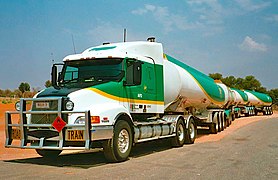Road train
A road train, land train or long combination vehicle is a trucking vehicle used to move road freight more efficiently than semi-trailer trucks. It consists of two or more trailers or semi-trailers hauled by a prime mover.[1] Long combination vehicles[2] are combinations of multiple trailers on tractor trucks as compared to standard 5 axle semi trailer-trucks with one trailer.
.jpg)
History
Early road trains consisted of traction engines pulling multiple wagons. The first identified road trains operated into South Australia's Flinders Ranges from the Port Augusta area in the mid-19th century.[3] They displaced bullock teams for the carriage of minerals to port and were, in turn, superseded by railways.
During the Crimean War, a traction engine was used to pull multiple open trucks.[4] By 1898 steam traction engine trains with up to four wagons were employed in military manoeuvres in England.[5]
In 1900, John Fowler & Co. provided armoured road trains for use by the British Armed Forces in the Second Boer War.[4][6] Lord Kitchener stated that he had around 45 steam road trains at his disposal.[7]
A road train devised by Captain Charles Renard of the French Engineering Corps was displayed at the 1903 Paris Salon. After his death, Daimler, which had acquired the rights, attempted to market it in the United Kingdom.[8][9] Four of these vehicles were successfully delivered to Queensland, Australia, before the company ceased production upon the start of World War I.[10]
In the 1930s/40s, the government of Australia operated an AEC Roadtrain to transport freight and supplies into the Northern Territory, replacing the Afghan camel trains that had been trekking through the deserts since the late 19th century. This truck pulled two or three 6 m (19 ft 8 in) Dyson four-axle self-tracking trailers. At 130 hp (97 kW), the AEC was grossly underpowered by today's standards, and drivers and offsiders (a partner or assistant) routinely froze in winter and sweltered in summer due to the truck's open cab design and the position of the engine radiator, with its 1.5 m (4 ft 11 in) cooling fan, behind the seats.
Australian Kurt Johannsen, a bush mechanic, is recognised as the inventor of the modern road train.[11] After transporting stud bulls 200 mi (320 km) to an outback property, Johannsen was challenged to build a truck to carry 100 head of cattle instead of the original load of 20. Provided with financing of about 2000 pounds and inspired by the tracking abilities of the Government roadtrain, Johannsen began construction. Two years later his first road train was running.[12]
Johannsen's first road train consisted of a United States Army World War II surplus Diamond-T tank carrier, nicknamed "Bertha", and two home-built self-tracking trailers. Both wheel sets on each trailer could steer, and therefore could negotiate the tight and narrow tracks and creek crossings that existed throughout Central Australia in the earlier part of the 20th century. Freighter Trailers in Australia viewed this improved invention and went on to build self-tracking trailers for Kurt and other customers, and went on to become innovators in transport machinery for Australia.
This first example of the modern road train, along with the AEC Government Roadtrain, forms part of the huge collection at the National Road Transport Hall of Fame in Alice Springs, Northern Territory.
Usage
Australia
The term road train is used in Australia. In contrast with a more common semi-trailer towing one trailer or semi-trailer, the prime mover of a road train hauls two or more trailers or semi-trailers. Australia has the longest and heaviest road-legal road trains in the world, weighing up to 200 tonnes (197 long tons; 220 short tons). They transport freight across some of the harshest environments on Earth.[1]
Double (two-trailer) road train combinations are allowed on some roads in most states of Australia, including specified approaches to the ports and industrial areas of Adelaide, South Australia[13] and Perth, Western Australia.[14] A double road train should not be confused with a B-double, which is allowed access to most of the country and in all major cities.[15]
In South Australia, B-triples up to 35.0 metres (114 ft 10 in) and two-trailer road trains to 36.5 metres (119 ft 9 in) were only permitted to travel on a small number of approved routes in the north and west of the state, including access to Adelaide's north-western suburban industrial and export areas such as Port Adelaide, Gillman and Outer Harbour via Salisbury Highway, Port Wakefield Road and Augusta Highway before 2017.[13] A project named Improving Road Transport for the Agriculture Industry added 7,200 kilometres (4,500 mi) of key routes permitted to operate vehicles over 30 m (98 ft 5 in) in 2015–2018.[16]
Triple (three-trailer) road trains operate in western New South Wales, western Queensland, South Australia, Western Australia and the Northern Territory, with the last three states also allowing AB-quads (B double with two additional trailers coupled behind). Darwin is the only capital city in the world where triples and quads are allowed to within 1 km (0.62 mi) of the central business district (CBD).[15]
Strict regulations regarding licensing, registration, weights, and experience apply to all operators of road trains throughout Australia.
Road trains are used for transporting all manner of materials: common examples are livestock, fuel, mineral ores, and general freight. Their cost-effective transport has played a significant part in the economic development of remote areas; some communities are totally reliant on regular service.
The multiple dog-trailers are unhooked, the dollies removed and then connected individually to multiple trucks at "assembly" yards when the road train gets close to populated areas.
When the flat-top trailers of a road train need to be transported empty, it is common practice to stack them. This is commonly referred to as "doubled-up" or "doubling-up". Sometimes, if many trailers are required to be moved at one time, they will be triple-stacked, or "tripled-up".
Higher Mass Limits (HML) Schemes are now in all jurisdictions in Australia, allowing trucks to carry additional weight beyond general mass limits. Some roads in some states regularly allowing up to 4 trailers at 53.5 metres (175 ft 6 in) long and 136 tonnes (134 long tons; 150 short tons).[17]
United States
In the United States, trucks on public roads are limited to two trailers (two 28 ft or 8.5 m and a dolly to connect; the limit is 63 ft or 19 m end to end). Some states allow three trailers, although triples are usually restricted to less populous states such as Idaho, Oregon, and Montana, plus the Ohio Turnpike[18] and Indiana East-West Toll Road. Triples are used for long-distance less-than-truckload freight hauling (in which case the trailers are shorter than a typical single-unit trailer) or resource hauling in the interior west (such as ore or aggregate). Triples are sometimes marked with "LONG LOAD" banners both front and rear. "Turnpike doubles"—tractors towing two full-length trailers—are allowed on the New York Thruway and Massachusetts Turnpike (Interstate 90), Florida's Turnpike, Kansas Turnpike (Kansas City - Wichita route) as well as the Ohio and Indiana toll roads.[19] The term "road train" is not commonly used in the United States; "turnpike train" has been used, generally in a pejorative sense.[20]
In the western United States LCVs are allowed on many Interstate highways. The only LCVs allowed nationwide are STAA doubles.[21]
Europe
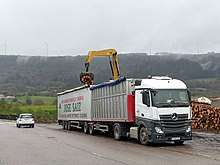
In Finland, Sweden, Germany, the Netherlands, Denmark, and some roads in Norway, trucks with trailers are allowed to be 25.25 m (82.8 ft) long.[22] In Finland 34.5 metres (113 ft) is allowed since January 2019, but the longest vehicles are 31.5 metres (103 ft) long because of cornering regulations. Elsewhere in the European Union, the limit is 18.75 m (61.5 ft) (Norway 19.5 m or 64 ft). The trucks are of a cab-over-engine design. These have a flat front and a high floor about 1.2 m (3.9 ft) above ground with the engine below. The Scandinavian countries are less densely populated than the other EU countries; and distances, especially in Finland and Sweden, are long. Until the late 1960s, vehicle length was unlimited, giving rise to long vehicles to handle goods cost effectively. As traffic increased, lengths became more of a concern and they were limited, albeit at a more generous level than in the rest of Europe. In the United Kingdom in 2009, a two-year desk study of Longer Heavier Vehicles (LHVs) including options up to 11-axle, 34-metre (111.5 ft) long, 82-tonne (81-long-ton; 90-short-ton) combinations, ruled out all road train type vehicles for the foreseeable future.
In 2010, Sweden was performing tests on log hauling trucks, weighing up to 90 t (89 long tons; 99 short tons) and measuring 30 metres (98.4 ft) and haulers for two 40 ft containers, measuring 32 metres (105 ft) in total.[23][24] In 2015 started a pilot in Finland to test 104 tonne timber lorry which length is 33 metres (108 ft) and has 13 axles. Testing of this special lorry is limited only for predefined route in northern Finland[25][26]
Since 2015 Spain has permitted B-doubles with a length of up to 25.25 metres (82.8 ft) and weighing up to 60 tonnes to travel on certain routes.[27]
Mexico
For Mexico the road trains exist in a very small form due the highway sizes and streets in the principal cities, and there are only permitted 2 trailers joined with a pup or dolly created for this purpose, recently the regulations tend to be more severe and strict to avoid overloading and frequent accident chance, to adhere to the federal rules of transportation. Truck drivers must obtain a certificate to certify that the driver is capable to manipulate and drive that type of vehicle.
All the tractor vehicles that make road train type transport in the country (along with the normal security requirements) need to have visual warnings like...
- "Precaucion Doble Semirremolque" alert (Warning Double Semi-Trailer) located in the frontal fenders of the tractor and in the rear part of each trailer.
- Some yellow turning lights of warning to be more visible to another drivers on the road
- a Seal for the entire vehicle approving the use as Double Semi Trailer.
- Federal License plates in every trailer, dolly, and Tractor unit
Some major cargo enterprises in the country use this form to cut costs of carrying all type of goods in some regions where another form of transportation are so expensive to improve it due the difficult geography of the country.[28]
The Mexican road train equivalent form in Australian Standard is the A-Double form, the difference is that the Mexican road trains can be hauled with a long distance tractor truck.
Trailer arrangements
A-double
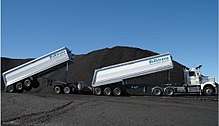
An A-double consists of a prime mover towing a normal lead trailer with a ball hitch (or some other type of coupling) affixed to it at the rear. A fifth wheel dolly is then affixed to the hitch allowing another standard trailer to be attached. Eleven-axle coal tipping sets carrying to Port Kembla, Australia are described as A-doubles. The set depicted has a tare weight of 35.5 tonne and is capable of carrying 50 tonne of coal.[29] Note the shield at the front of the second trailer to direct tipped coal from the first trailer downwards.
Pros include the ability to use standard semi-trailers and the potential for very large loads. Cons mainly include very tricky reversing due to the multiple articulation points across two different types of coupling.
B-double

A B-double consists of a prime mover towing a specialised lead trailer that has a fifth-wheel mounted on the rear towing another semi-trailer, resulting in two articulation points. It may also be known as a B-train, interlink in South Africa, B-double in Australia, tandem tractor-trailer, tandem rig or double in the United States. They may typically be up to 27.5 m (90 ft 3 in) long. The fifth wheel coupling is located at the rear of the lead, or first trailer and is mounted on a "tail" section commonly located immediately above the lead trailer axles.[30] In North America this area of the lead trailer is often referred to as the "bridge". The twin-trailer assembly is hooked up to a tractor unit via the tractor unit's fifth wheel in the customary manner.
An advantage of the B-train configuration is its inherent stability when compared to most other twin trailer combinations, the turntable mounted on the forward trailer results in the B-train not requiring a converter dolly as with all other road train configurations.[31] It is this feature above all else that has ensured its continued development and global acceptance.[32] Reversing is simpler as all articulation points are on fifth wheel couplings.
B-train trailers are used to transport many types of load and examples include tanks for liquid and dry-bulk, flat-beds and curtain-siders for deck-loads, bulkers for aggregates and wood residuals, refrigerated trailers for chilled and frozen goods, vans for dry goods, logging trailers for forestry work and cattle liners for livestock.
In Australia, standard semi-trailers are permitted on almost any road. B-doubles are more heavily regulated, but routes are made available by state governments for almost anywhere that significant road freight movement is required.[33]
Around container ports in Australia there may also have what is known as a super B-double, i.e. a B-double with a quad axle lead trailer capable of holding one 40-foot shipping container or two 20-foot shipping containers, and the rear trailer being capable of the same with either a tri or quad rear axle set. However, because of their length and low accessibility into narrow streets, these vehicles are restricted in where they can go and are generally used for terminal-to-terminal work, i.e. wharf to container holding park or wharf-to-wharf. The rear axle on each trailer can also pivot slightly while turning to prevent scrubbing out the edges of the tyres due to the heavy loads placed on them.
B-triple
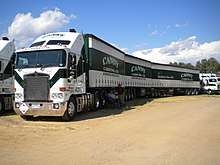
Same as B-double, but with an additional lead trailer behind the prime mover. The B-train principle has been exploited in Australia, where configurations such as B triples, double-B doubles and 2AB quads are permitted on some routes. Same as a B-double but with an additional lead trailer behind the prime mover.[34] These are run in most states of Australia where double road trains are allowed. Australia's National Transport Commission proposed a national framework for B-triple operations that includes basic vehicle specifications and operating conditions that the commission anticipates will replace the current state-by-state approach, which largely discourages the use of B-triples for interstate operation.[35] In South Australia, B-triples up to 35.0 metres (114 ft 10 in) and two-trailer road trains to 36.5 metres (119 ft 9 in) are generally only permitted on specified routes, including access to industrial and export areas near Port Adelaide from the north.[33]
AB triple
An AB triple consists of a standard trailer with a B-Double behind it using a converter dolly, with a trailer order of Standard, Dolly, B-Train, Standard. The final trailer may be either a B-Train with no trailer attached to it or a standard trailer.
A-triple
In South Australia, larger road trains up to 53.5 metres (175 ft 6 in) (three full trailers) are only permitted on certain routes in the Far North.[33]
BAB quad
A BAB quad consists of two B-double units linked with a converter dolly, with trailer order of Prime Mover, B-Train, Dolly, B-Train.
C-train
A C-train is a semi-trailer attached to a fifth-wheel on a C-dolly. Unlike in an A-Train, the C-dolly is connected to the tractor or another trailer in front of it with two drawbars, thus eliminating the drawbar connection as an articulation point. One of the axles on a C-dolly is self-steerable to prevent tire scrubbing. C-dollies are not permitted in Australia, due to the lack of articulation.
Dog-trailer (dog trailer)
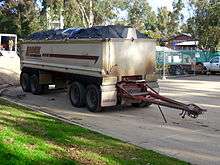
A dog-trailer (also called a pup) is any trailer that is hooked to a converter dolly, with a single A-frame drawbar that fits into the Ringfeder or pintle hook on the rear of the trailer in front, giving the whole unit three to five articulation points and very little roll stiffness.
Interstate road transport registration in Australia
In 1991, at a special Premiers' Conference, Australian heads of government signed an inter-governmental agreement to establish a national heavy vehicle registration, regulation and charging scheme, otherwise known as FIRS.[36]
This registration scheme is known as the Federal Interstate Registration Scheme. The requirements of the scheme were as follows:
If the vehicle was purchased to be used for interstate trade, no stamp duty was payable on the purchase price of the vehicle.
The vehicle had to be subjected to an annual inspection for roadworthy standards, which had to be passed before registration could be renewed.
With the registration identification; the first letter of the 6 digit identified the home state: W, Western Australia; S, South Australia; V, Victoria; N, New South Wales; Q, Queensland; T, Tasmania; A, Australian Capital Territory and C, Northern Territory.
Due to the 'eastern' and 'western' mass limits in Australia, two different categories of registration were enacted. The second digit of the registration plate showed what mass limit was allowed for that vehicle. If a vehicle had a 'V' as the second letter, its mass limits were in line with the eastern states mass limits, which were:
- Steer axle, 1 axle, 2 tyres: 5.40 t (5.31 long tons; 5.95 short tons)
- Steer axle, 2 axles, 2 tyres per axle: Non load sharing suspension 9.00 t (8.86 long tons; 9.92 short tons)
- Load sharing suspension 10.00 t (9.84 long tons; 11.02 short tons)
- Single axle, dual tyres: 8.50 t (8.37 long tons; 9.37 short tons)
- Tandem axle, dual tyres: 15.00 t (14.76 long tons; 16.53 short tons)
- Tri-axle, dual tyres or 'super single' tyres: 18.00 t (17.72 long tons; 19.84 short tons)
- Gross combination mass on a 6-axle vehicle not to exceed 38 t (37 long tons; 42 short tons)
If a vehicle had an X as the second letter, its mass limits were in line with the western states mass limits, which were:
- Steer axle, 1 axle, 2 tyres: 6.00 t (5.91 long tons; 6.61 short tons)
- Steer axle, 2 axles, 2 tyres per axle
- Non load sharing suspension 10.00 t (9.84 long tons; 11.02 short tons): Load sharing suspension 11.00 t (10.83 long tons; 12.13 short tons)
- Single axle, dual tyres: 9.00 t (8.86 long tons; 9.92 short tons)
- Tandem axle, dual tyres: 16.50 t (16.24 long tons; 18.19 short tons)
- Tri-axle, dual tyres or "super single" tyres: 20.00 t (19.68 long tons; 22.05 short tons)
- Gross combination mass on a 6-axle vehicle not to exceed 42.50 t (41.83 long tons; 46.85 short tons)
The second digit of the registration being a T designates a trailer.
One of the main criteria of the registration was that intrastate operation was not permitted. The load had to come from one state and be delivered to another state or territory. Many grain carriers were reported and prosecuted for cartage from the paddock to the silos. If, though, they went to a port silo, they were given the benefit of the doubt, as that grain was more than likely going overseas.
Signage
Australian road trains have horizontal signs front and back with 180 mm (7.1 in) high black uppercase letters on a reflective yellow background reading "ROAD TRAIN". The sign(s) must have a black border and be at least 1.02 m (3.3 ft) long and 220 mm (8.7 in) high and be placed between 500 mm (19.7 in) and 1.8 m (5.9 ft) above the ground on the fore or rearmost surface of the unit.
In the case of B-triples in Western Australia, they are signed front and rear with "ROAD TRAIN" until they cross the WA/SA border where they are then signed with "LONG VEHICLE" in the front and rear.
Converter dollies must have a sign affixed horizontally to the rearmost point, complying to the same conditions, reading "LONG VEHICLE". This is required for when a dolly is towed behind a trailer.
Combination lengths
- B-double
- 26 m (85.3 ft) max. Western Australia, 27.5 m (90.2 ft) max.
- B-triple
- up to 36.5 m (120 ft) max.
- NTC modular B-triple
- 35.0 m (115 ft) max. (uses 2× conventional B-double lead trailers)
- Pocket road train
- 27.5 m (90.2 ft) max. (Western Australia only) This configuration is classed as a "Long Vehicle".
- Double road train or AB road train
- 36.5 m (120 ft) max.
- Triple and ABB or BAB-quad road trains
- 53.5 m (176 ft) max.
Operating weights
Operational weights are based on axle group masses, as follows:
- Single axle (steer tyre)
- 6.0 t (5.9 long tons; 6.6 short tons)
- Single axle (steer axle with 'super single' tyres)
- 6.7 t (6.6 long tons; 7.4 short tons)
- Single axle (dual tyres)
- 9.0 t (8.9 long tons; 9.9 short tons)
- Tandem axle grouping
- 16.5 t (16.2 long tons; 18.2 short tons)
- Tri-axle grouping
- 20.0 t (19.7 long tons; 22.0 short tons)
Therefore,
- A B-double (single axle steering, tandem drive, and two tri-axle groups) would have an operational weight of 62.5 t (61.5 long tons; 68.9 short tons).
- A double road train (single axle steering, tandem drive, tri-axle, tandem, tri-axle) would have an operational weight of 79 t (78 long tons; 87 short tons).
- A triple is 115.5 t (113.68 long tons; 127.32 short tons).
- Quads weigh in at 135.5 t (133.4 long tons; 149.4 short tons).
- Concessional weight limits, which increase allowable weight to accredited operators[37] can see (for example) a quad weighing up to 149 t (147 long tons; 164 short tons).
- If a tri-drive prime mover is utilised, along with tri-axle dollies, weights can reach nearly 170 t (167 long tons; 187 short tons).
Speed limits
The Australian national heavy vehicle speed limit is 100 km/h (62 mph), excepting:
- NSW & Queensland where the speed limit for any road train is 90 km/h (56 mph).
In western Canada, LCVs are restricted to 100 km/h (62 mph), or the posted speed limit. Trucks of legal length (25 metres or 82 feet) may travel at 110 km/h (68 mph), or the posted speed limit.
World's longest road trains
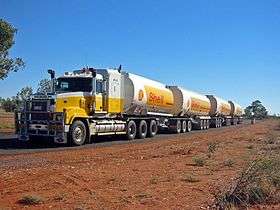
Below is a list of longest road trains driven in the world. Most of these had no practical use, as they were put together and driven across relatively short distances for the express purpose of record-breaking.
- In 1989, a trucker named "Buddo" tugged 12 trailers down the main street of Winton.[38]
- In 1993, "Plugger" Bowden took the record with a 525 hp (391 kW) Mack CLR pulling 16 trailers.
- A few months later this effort was surpassed by Darwin driver Malcolm Chisholm with a 290-tonne (285-long-ton; 320-short-ton), 21 trailer rig extending 315 metres (1,033 ft).[38]
- In April 1994 Bob Hayward and Andrew Aichison organised another attempt using a 1988 Mack Super-Liner 500hp V8 belonging to Plugger Bowden who drove 29 stock trailers measuring 439.169 metres a distance of 4.5km into Bourke.[39] The record was published in the next Guinness Book of Records.
- Then the record went back to Winton with 34 trailers.[38]
- In 1999, the town of Merredin, officially made it into the Guinness Book of Records, when Marleys Transport made a successful attempt on the record for the world's longest road train. The record was created when 45 trailers, driven by Greg Marley, weighing 603 t (593 long tons; 665 short tons) and measuring 610 m (2,001 ft) were pulled by a Kenworth 10×6 K100G for 8 km (5 mi).[38][40]
- On 19 October 2000, Doug Gould set the first of his records in Kalgoorlie, when a roadtrain made up of 79 trailers, measuring 1,018.2 m (3,341 ft) and weighing 1,072.3 t (1,055.4 long tons; 1,182.0 short tons), was pulled by a Kenworth C501T driven by Steven Matthews a distance of 8 km (5 mi).[38][41]
- On 29 March 2003, the record was surpassed near Mungindi, by a road train consisting of 87 trailers and a single prime mover (measuring 1,235.3 m (4,053 ft) in length).[42]
- The record returned to Kalgoorlie, on 17 October 2004, when Doug Gould assembled 117 trailers for a total length of 1,445 m (4,741 ft). The record nearly didn't fall, as the first prime mover's main driveshaft broke when taking off. A second truck was quickly made available, and pulled the train a distance of 1,500 m (4,921 ft).[43]
- In 2004, the record was again broken by a group from Clifton, Queensland which used a standard Mack truck to pull 120 trailers a distance of about 100 metres (328 ft).[44]
- On 18 February 2006, an Australian built Mack truck with 113[45] semi-trailers, 1,300 t (1,279 long tons; 1,433 short tons) and 1,474.3 metres (4,836 ft 11 in) long, pulled the load 100 metres (328 feet) to recapture the record for the longest road train (multiple loaded trailers) ever pulled with a single prime mover. It was on the main road of Clifton, Queensland, that 70-year-old John Atkinson claimed a new record, pulled by a tri-drive Mack Titan.[46][47][48]
Gallery
.jpg) Sherwin-Williams Paints truck on US 95 Nevada
Sherwin-Williams Paints truck on US 95 Nevada.jpg) 53 foot container turnpike double in Canada
53 foot container turnpike double in Canada.jpg) Triple trailer three 28.5-foot pups
Triple trailer three 28.5-foot pups- A B-double tanker parked at a truck stop
 long combination vehicle routes
long combination vehicle routes
See also
- Air brake (road vehicle)
- Articulated bus
- Brake
- B-train
- Containerization
- Container on barge
- Container ship
- Dolly (trailer)
- Federal Bridge Weight Formula
- Fifth wheel coupling
- Gladhand connector
- Intermodal freight transport
- Jackknifing
- Longer Heavier Vehicle
- National Network – highway and interstate system
- Overland train
- Ringfeder coupling devices
- Road transport in Australia
- Rolling highway – freight trucks by rail
- Semi-trailer truck – large trucks such as road trains and articulated lorries
- Shipping container
- Top intermodal container companies list
- Trackless train
- Transport
Notes
- "What is a Road Train?". X. Vintage Road Haulage, Perth, Western Australia. 2018. Retrieved 4 December 2018.
- "CDL Combination Vehicles Endorsement Practice Test". TestQuestionsAndAnswers.com. US: National Safety Commission, Inc. Retrieved 28 September 2018.
- Fuller, Basil (1975). The Ghan: The Story of the Alice Springs Railway. Rigby. ISBN 978-0727000163.
- Beavan, Arthur H. (1903). Tube, Train, Tram, and Car or Up-to-date Locomotion. London: G. Routledge & sons. p. 217.
- Layriz, Otfrie; Marston, Robert Bright (1900). Mechanical traction in war for road transport, with notes on automobiles generally. London: S. Low, Marston and Company. p. 20.
- The Illustrated war news. 29 November 1916.
- Wyatt, Horace Matthew (1914). Motor transports in war. Hodder and Stoughton. pp. 43–44.
- Burgess-Wise, David (17 August 2001). "A good idea at the time: Renard Road Train". The Telegraph. ISSN 0307-1235. Retrieved 5 August 2018.
- Spooner, Stanley (1907). The Auto: The Motorist's Pictorial. Pictorial Press.
- http://www.farinarestoration.com/page4/page81/index.html
- View From The North - Episode Four: Roads North
- BBC Worldwide, Jeremy Clarkson's Motorworld, Australian episode
- RAVnet (Map). Government of South Australia. Retrieved 21 October 2016.
- "Heavy Vehicles". Main Roads Western Australia. Retrieved 21 October 2016.
- Hema Maps (Firm) & Martin, Ray. & Martin, Will. (2007), Australia truckies atlas [cartographic material] : the complete atlas for the professional driver / Hema Maps ; [cartography, Ray Martin and Will Martin] - ISBN 978-1-86500-426-6 ISBN 1-865004-26-X - has state by state routes and route restrictions I
- "IMPROVING ROAD TRANSPORT FOR PRIMARY PRODUCTION PROJECT Status update" (PDF). Primary Industries and Regions SA. February 2018. Retrieved 24 August 2019.
- "Common Heavy Freight Vehicle Configurations - NHVR" (PDF). National Heavy Vehicle Regulator. Retrieved 24 August 2018.
- "Truck Driver's Guide Book"
- "Fact #411 States that Allow Longer Combination Vehicles". U.S. Department of Energy - Energy Efficiency and Renewable Energy Vehicle Technologies Office. 13 February 2006.
- "Gangway! Here comes a turnpike train!", The Times-News (Hendersonville, N.C.), 30 Nov. 1960, p. 7.
- "Chapter 3: Scenario Descriptions". Comprehensive Truck Size and Weight (CTS&W) Study (PDF). Volume 3. US: Department of Transportation - Federal Highway Administration. Retrieved 28 September 2018.
- "Effektive og miljørigtige lastbiler på de danske veje" (Press release) (in Danish). Transport og Energiministeriet. 24 November 2008. Archived from the original on 14 December 2008.
- The next environmental improvement - Long truck rigs Volvo Trucks Magazine 2008-10-03
- "Miljövänlig jättebil med timmer". Västerbottens-Kuriren (in Swedish). TT. 8 October 2010. Archived from the original on 24 July 2011.
- Largest lorry in western Europe to start operating in Finnish Lapland
- 104 ton experiment in northern Finland
- http://www.cadenadesuministro.es/wp-content/uploads/2015/12/Modificacion-del-Anexo-IX-del-Reglamento-General-de-Vehi%CC%81culos-copia.pdf
- Notice of regulation https://www.elmananerodiario.com/los-doble-remolque-no-se-prohiben-tendran-regulacion-mas-estricta/
- Muscat Trailer website
- "Code of Practice for B-Doubles" (PDF). Government of South Australia, Department for Transport, Energy and Infrastructure. June 2011. p. 3. MR 414 06/11. Archived from the original (PDF) on 21 October 2016. Retrieved 8 February 2016.
- "Into the Details: All About Road Trains". Equipment Hunt Group Pty Ltd. April 2019. Retrieved 9 April 2019.
- Sweatman, P.; Tso, Y. (29 July 1988). "Dynamic stability of B‐doubles". Transportation Planning and Technology. 14 (2): 159–169. doi:10.1080/03081068908717423.
- RAVnet (Map). Government of South Australia. Retrieved 26 July 2020.
- COAG backs B-triple network Archived 2008-07-29 at the Wayback Machine, ntc.gov.au
- Bereni, Matthieu; Rob Di Cristoforo (2012). "Connecting Australia with Modular B-Triples". Transportation Research Record. Washington, D.C. 2288 (2288): 57–65. doi:10.3141/2288-07.
- Interstate Road Transport Charge Amendment Bill 1998 (Bills Digest 192 1997-98)
- "Concessional Mass Limits". National Heavy Vehicle Regulator (nhvr.gov.au). Retrieved 1 December 2019.
- Doug's Tug Archived 2009-09-30 at the Wayback Machine, the pick & shovel (13), December 2000.
- The world's longest roadtrain Truck & Bus Transportation June 1994 page 6
- The Truck Pull : The World's Longest Road Train, marleystransport.com
- World records : Preparations for the Big Attempt Archived 2009-04-12 at the Wayback Machine, gouldtransport.com.au, quoted from Kalgoorlie Miner, Friday 10 November 2000.
- TALKIN' TITAN TOUGH, 21 November 2005, macktrucks.com.au
- Monster Update : ROAD TRAIN RECORD Archived 2009-08-26 at the Wayback Machine Fleet Watch,
- Former road train record holder may take on new challenge, 22 February 2006, ABC News online,
- Guinness World Records https://www.guinnessworldrecords.com/world-records/longest-road-train. Retrieved 5 December 2019. Missing or empty
|title=(help) - Australia's New World Record Road Train Pull, thedieselgypsy.com
- Qld truck driver sets world's longest road train record, 19 February 2006, ABC News.
- Bulldog Reclaims Record Down Under, macktrucks.com
External links
| Wikimedia Commons has media related to Road trains. |
- Australian Road Train Association
- Australian National Heavy Vehicles Accreditation Scheme.
- Northern Territory Road Train road safety TV commercials.
- South Australian Roads road train gazette
- NSW Roads and Traffic Authority road train operators gazette
- NSW Roads and Traffic Authority Restricted Access Vehicles route map index
- NSW Roads and Traffic Authority Reflective sign standards
- U.S. department of Transportation, Federal Highway Administration, Chapter VII, Safety.
- The U.S. Department of Transportation's Western Uniformity Scenario Analysis.
- British Columbia Government Licensing Bulletin 6
- British Columbia Government Licensing Bulletin 41
- Roadmap of technologies able to halve energy use per passenger mile includes the dynamically coupled, heterogeneous type of roadtrain
- Road trains and electrification of transport
- Combination Vehicles for Commercial Drivers License
